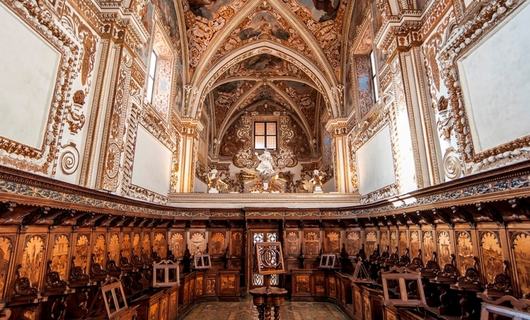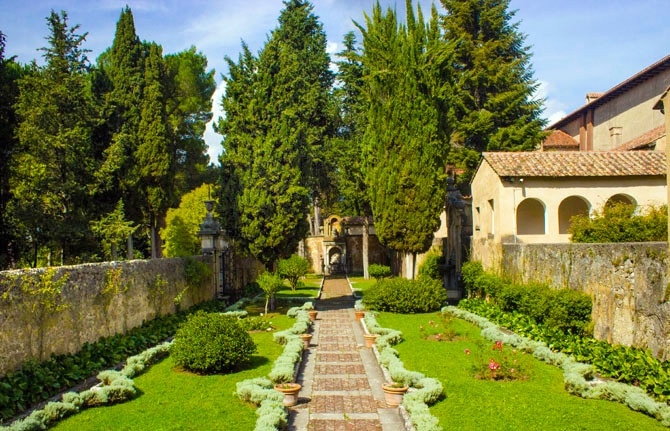|
Vallo di Diano - The Inland Cilento Plateau The complete name of the national park zone is Parco Nazionale del Cilento e Vallo di Diano (Cilento National Park and the Valley of Diana). There are really two parts to the park... the Cilento Coast with its seaside towns, beaches and the mountains, and inland, the Vallo di Diano. This broad valley ( 5 miles wide by 20 miles long) is naturalist's wonderland and can be a relaxing contrast to the beachy summertime holiday vibe of the coastal beach towns--especially during the high season. There are flowering meadows, dense forests, with the dramatic mountains feeding the many streams, rivers and waterfalls. A UNESCO Site, it is the second-largest national park in Italy, covering nearly 700 square miles and containing 80 villages. Besides the history of Greeks, Romans and others, during more modern history these mountains were plagued by roaming briganti (bandits). Today, you are safe from kidnapping or thievery--not to worry. If necessary, you can say your prayers at the largest monastery in Europe. One method of getting a good taste of both the coastal beaches and mountains as well as the Vallo di Diano is to start at Paestum, moving down the coast visiting the various towns and points of interest, then after exploring Capo Palinuro, make a turn up toward the mountains and the valley, heading north again, thus doing a sort of loop of the entire region. There are many discoveries to be made in the Vallo...  Sanzo, on its hilltop surrounded by mountains Sanzo, on its hilltop surrounded by mountains The hilltown of Sanza will be your first stop when traveling up from Palinuro toward the Vallo di Diano. While it does have an old historic center at the top of the village, the town can be thought of as a pit stop while traveling. As a workaday Italian town, it has gas stations, restaurants, alimentari (small food markets) and hardware stores... in other words, it's a place to stop to fill your tank and pick up picnic supplies. You might find its location fairly interesting, too, as it's surrounded by some pretty majestic mountains--for one, the extinct volcano Monte Cervati is over 6000 feet tall, the highest mountain in all of Campania.  A hermitage and sanctuary dug into the rocks near the summit of Cervati A hermitage and sanctuary dug into the rocks near the summit of Cervati This area has a strong appeal for serious trekkers, mountain climbers or back country mountain bikers... there are several trail heads just before you reach the town. One dirt road travels up to a small mountain chapel pilgrimage about a mile west of the summit. Otherwise, there is a loop trail that starts at the north end of Sanza which is 35 miles long with an elevation challenge of nearly 5000 feet! If you are traveling with a 4 wheel drive vehicle, you can drive up toward Cervati and start your trek or cycling adventure from higher up the mountain. If you're into serious mountain cycling, this is the place for you. In winter, the place is well known for snowboarding. The views from the bald, rocky top of Cervati are amazing but during the journey you might come upon mountain goats, sheep, grazing buffalo, wild boar, wolves (yes, they have some here), hawks and eagles. The trails may also lead to waterfalls, majestic cliff overlooks, caves and even a tunnel or two. Note: Although you can drive fairly high on the mountain with a 4-wheeler, this is serious back country. Don't travel alone. Cell phone service is spotty. Mountain rescue is fairly non-existant. Bring a hand-held GPS unit if possible. Day trips only--do not consider camping on the bare-topped mountain. Carry lots of water. If you are into more flat land cycling and trekking, consider trekking in the valley below.  Montesano sulla Marcellana is another workaday hilltown about 8 miles further east on the other edge of the Vallo di Diano. You will find this one a bit more attractive in terms of architecture as this town has a history going back 1000 years with a varied cultural past during the Renaissance. It's an odd hilltown in that it's missing its castello or rocca at the top (Google Earth shows just a wide flat parking area, but there might be new construction going on at the time of this writing). Its obvious crowning glory is a rather late addition--Sant'Anna a Montesano, the twin-spired Gothic cathedral built in the 1950s with a grand exterior but a rather bland interior when compared to most other basilicas or cathedrals in Italy. If anything, this village is worth a visit if only to take in the wide panoramic views of the entire expanse of the Vallo surround by its mountains. Certosa di San Lorenzo Monastery  Sitting on the eastern edge of the Vallo di Diano, just below the hilltown of Padula, is a "monastery" claimed to be one of the largest in southern Europe... the Certosa di San Lorenzo. I put "monastery" in quotes for good reason. Looking more like an over-indulgent palazzo on the scale of Versailles rather than a stern, stark monastery, the Certosa dates from 1306 and covers nearly a square mile and contains: 320 rooms and halls, a mile and a half of corridors, galleries and hallways, 300 columns, 500 doors, 550 windows, 13 courtyards, 100 fireplaces, 52 stairways (some are magnificent) and 41 fountains. And I haven't even talked about the huge formal gardens. I can't imagine monks here spending much time meditating and praying in their cells.
As you can imagine, you can spend a lot of time trying to see everything at Certosa di San Lorenzo. If you would like to visit here, you might consider a stay in the little hilltown of Padula overlooking the monastery. The Certosa is one of the crowning highlights of a Voyage through the Vallo di Diano--don't miss it, but allow enough time to explore it fully. While in Padula, there is one other site worth taking a look at just up the hill from the town... San Michele alle Grottelle. The grotto's history stretches back to pagan times honoring the god Attis, but has been used as a Christian pilgrimage since before the time of Constantine, when Christian worship was literally forced underground. Today you can see an outer structure dating to the 10th century AD with frescoes from the 14th century. The sacristy is made from the rock on which the church stands.  The spring flowing through the main chamber The spring flowing through the main chamber About a mile and a half north of the Certosa di San Lorenzo is the Battistero di San Giovanni in Fonte, a paleo-Christian baptistry unlike any other in the world--its baptismal waters come directly from the natural spring flowing through the building. The site was used worship a pagan nymph, but since the 4th century has been used for Evangelical baptisms. As a plus, there is a wonderful agriturismo B&B right next to the Battistero growing not only their own produce but having a fish farm growing trout--La Fonte Agristurismo. Sassano and its Valley of Orchids The Valley of Orchids (Valle delle Orchidee) is located in Sassano, right in the heart of the Vallo on the western slope opposite Padula. The orchids bloom from April to June, and even some varieties keep flowering until July. Within a 20 square mile area, you can observe 68 species of wild orchids plus 57 subspecies, 35 varieties and 24 hybrids. The entire Vallo actually boasts 254 species of wild orchids. Every year in May, Sassano celebrates the wild orchid with its Festival of the Orchids with free guided tours, tastings of local products, and regional folk music. Teggiano The hilltown of Teggiano sitting over 2000 feet above sea level, on the eastern edge of the Vallo di Diano, has a history going back to the 4th century AD, originally an ancient Roman colony of Nero. The proof of its antiquity can be seen in an ancient Roman bridge and inscriptions in the town in Greek letters. You can think of Teggiano as a medieval museum which includes, The Castle of Sanseverino; the Cathedral with XIII century doors; the Church of Annunziata with its frescoes; the Church of St Angelo with a crypt from the year 1200; the Church of SS. Pietà (medieval cloister, frescoes and statues); the Diocesano Museum; and the Museum of Rural Civilization.  Renaissance festival Renaissance festival Sitting about 600 feet above the valley below, this is possibly one of the more beautiful hilltowns of the Vallo di Diano with several piazze and belvedere that afford majestic views of the valley and mountains surrounding the town. A very civilized town, there is even indoor parking at the top of the town! There are also incredibly wide piazze and viale--unusual for a small hilltown. It's a town for walking and taking in the wonderful architecture, such as the 15th century Norman fortress, Castello Sanseverino and its many churches and chapels. There are even some hidden gardens and many Italian style pot gardens. The feel is Renaissance, many of the houses having "Juliette balconies" and arched alleyways. There are often festivals and sagre in the town to enjoy throughout the year. And don't forget to get a viewpoint at night of the illuminated village from higher up on the mountain or from the valley below. Teggiano would be a practical place to stay for a few days to a week while exploring the rest of what the Vallo di Diano has to offer. If you decide to stay in the town, you can rent beautiful rooms in Castello Sanseverino or other apartments in the village for about $100 a night or less. I can imagine a one week stay in a Cilento coastal town like Santa Maria di Castellabate for exploring the coast or doing some boating, then another week in Teggiano while enjoying what the Vallo and surrounding mountains have to offer. Atena Lucane The Lucani were the native people living in the Vallo di Diano during the 6th and 3rd centuries BC. The megalithic walls in Atena Lucane date back to the 500 BC with both Greek and Roman dominance the 4th to 2nd centuries BC. Many historians claim this is the oldest settlement in the entire Vallo. This hilltown is tiny--only 1/4 mile wide but has fine views of the Vallo. There is a small archeological museum and a 12th century castle. The other reason to stop at this village is to do some trekking in the nearby Arenaccia valley where you will see mountain torrents, waterfalls and many caves. (Click to see a map of hiking paths in Atena Lucane). Polla The medieval village of Polla can be enjoyed for its medieval historic center, its many churches, a 12th-century castle and the Franciscan monastery of Santuario di Sant'Antonio. It should be of particular interest to cavers and hiking enthusiasts thanks to the karst nature of the mountain above the town. The Grotta di Polla is located just below a tall rock cliff on the drive up Via delle Grotte, just below the Santuario. The cave's artifacts date it back to the stone and bronze ages. Polla is also a place for culinary pleasures, handcrafted folk costumes and their annual Pizza Festival. Copyright 2017, Jerry Finzi/Grand Voyage Italy - All Rights Reserved
|
Categories
All
Archives
May 2023
|





















 RSS Feed
RSS Feed
